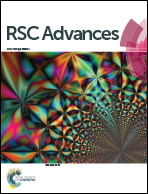Differential interactions of imatinib mesylate with the membrane skeletal protein spectrin and hemoglobin
Abstract
The anti-leukaemia drug imatinib mesylate has been shown to bind to the membrane skeletal protein, spectrin, and to the most abundant erythroid protein, HbA, in its oxy-form with binding dissociation constants of 48 μM and 63 μM at 25 °C, respectively. Such binding dissociation constants are detected by monitoring imatinib induced quenching of the tryptophan fluorescence of the proteins with increasing concentration. The thermodynamic parameters associated with such binding reveal the binding to be favoured by positive changes in entropy. Circular dichroism studies show significant changes in the secondary structure of dimeric spectrin and in the tertiary structure of HbA, α-globin and β-globin chains, indicating a marked difference in the molecular mechanism of binding of imatinib with the two different erythrocyte proteins. We have also found imatinib to bind to both the globin chains with higher affinity compared to the HbA tetramer. Molecular docking studies reveal imatinib to show a preference for the β-globin chain, however, the binding parameters are comparable for the two globin chains. This is the first study showing favourable interactions of this anticancer agent with the two major erythroid proteins which could shed light on understanding the mechanism of action and toxicity of this drug, which need to be optimized for cancer treatment.


 Please wait while we load your content...
Please wait while we load your content...